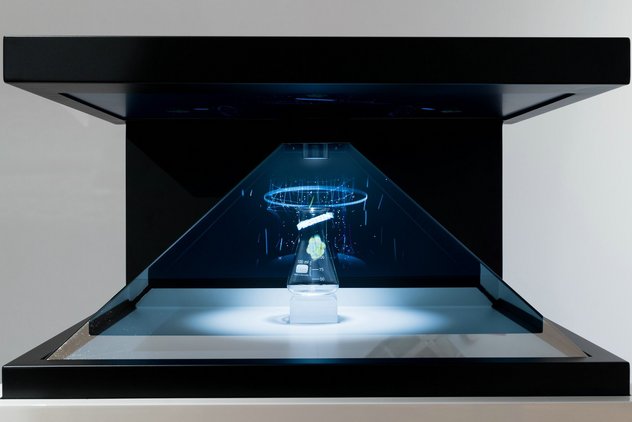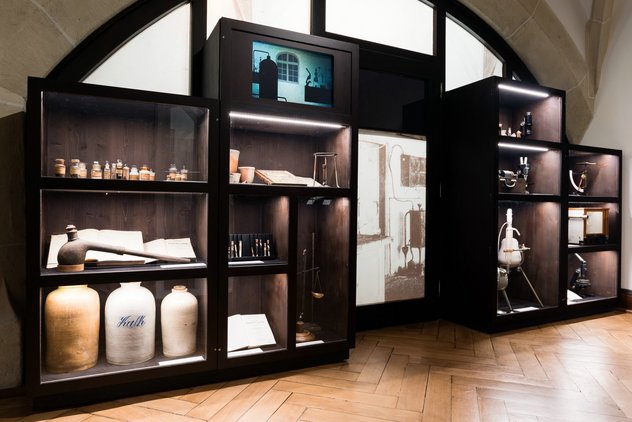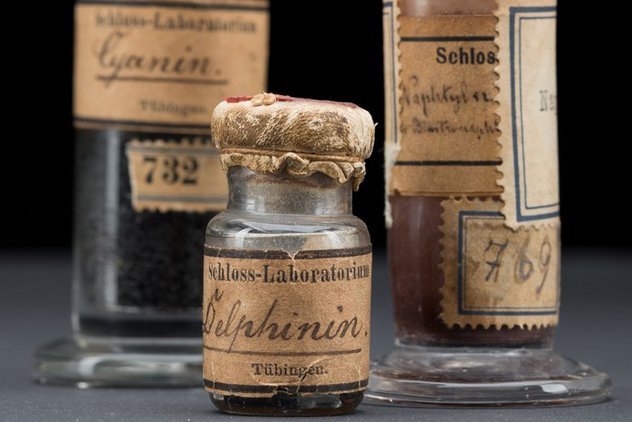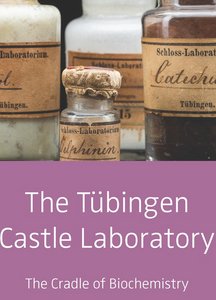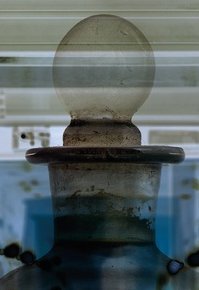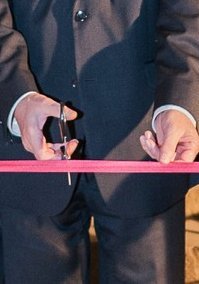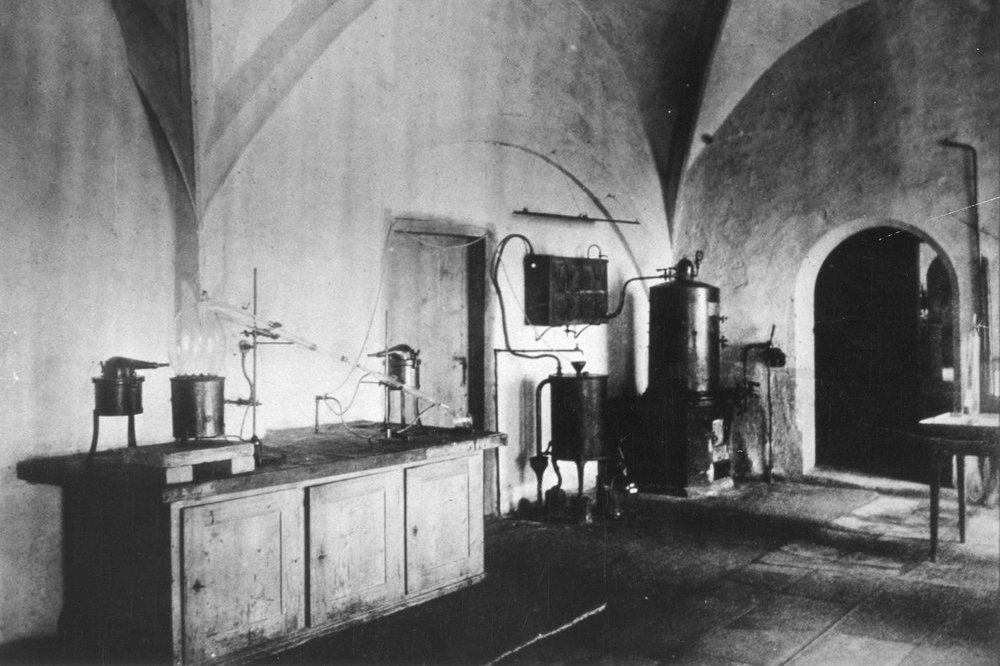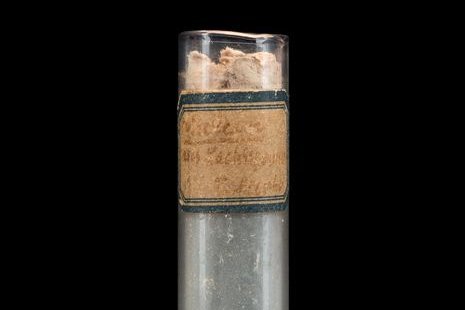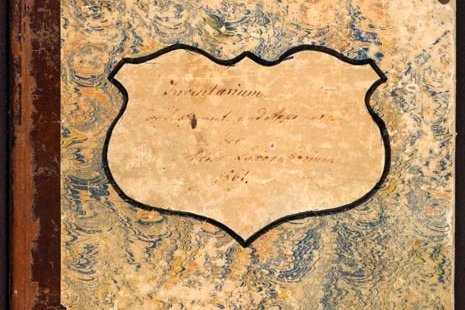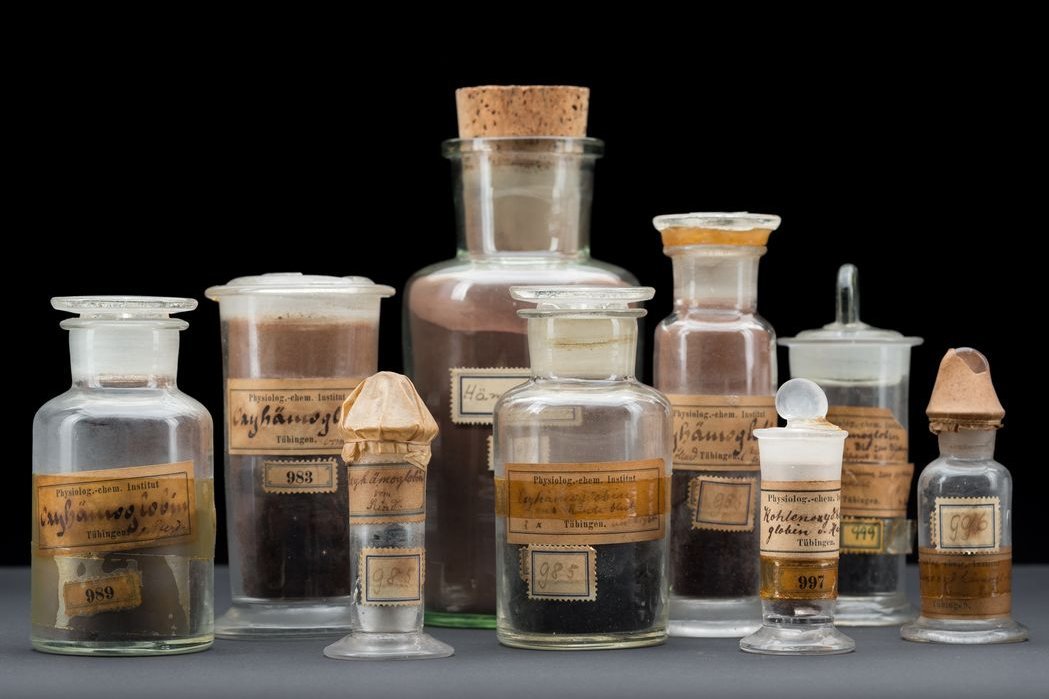Castle Laboratory
The permanent exhibition „Castle Laboratory Tübingen – The Cradle of Biochemistry” in the historical castle laboratory conveys the big significance of the Tübingen biochemistry from the beginnings to the present. Historical tools and preparations give an impression of the laboratory work in the 19th century. Interactive media conveys insights into the modern biochemistry research
A Significant Place of Scientific History
The not yet accessible, original test tube with nucleic acid from Friedrich Miescher is the main focus of the presentation. Miescher had discovered the substance, which was first identified as carrier of the genetic material decades later, in the year 1869 in this place.
In the former kitchen of the Tübingen castle the university set up a chemical laboratory in 1818 which soon became one of the worldwide first research centers for biochemistry. Georg Carl Sigwart and Julius Eugen Schlossberger belonged to the pioneers of this subject that researched the chemical advances in the living, especially the human’s metabolism.
Outstanding research was carried out by the early Tübingen biochemistry in the era of Felix Hoppe-Seyler who was appointed as professor in 1861. He researched the red blood pigment and named it “haemoglobin”.
In 1869 his pupil Friedrich Miescher made the groundbreaking discovery of a substance in the castle laboratory and named it “nucleic” – today known as DNA and RNA, the carriers of the genetic information.
In this tradition, the conclusion was made to make the historical castle laboratory accessible again from 2015 onwards: The Tübingen biopharma company CureVac financed the museum’s interior from moneys of a European research prize. What Friedrich Miescher once discovered here is the basis of future-oriented research for new vaccines and immunotherapy against cancer in Tübingen today.
Visit Exhibitions
Opening Hours
Wednesday to Sunday 10am till 5pm,
Thursday till 7pm
Tours
For groups by arrangement in advance, in German or English language
Contact
Museum of the University of Tübingen MUT | Castle Laboratory TübingenE-mail: museum@uni-tuebingen.de Tel: 07071 / 29-77579
Current Publications
Accompanying Publication
Thomas Beck: Castle Laboratory Tübingen. The Cradle of Biochemistry, Tübingen 2015
90 pages, paperback, throughout colored images ISBN 978-3-9817947-2-4
The accompanying publication traces the history of the Tübingen biochemistry and places the most important exhibits of the castle laboratory into their historical context. The booklet was published in the series “Small Monographs of MUT” and is available for the price of 4,90€ in bookshops, in the shop of the museum in Castle Hohentübingen as well as in the dispatch at the Museum of the University of Tübingen MUT.
Special Exhibition: Bernd Haussmann – the Nucleus Project
22. April – 24. June 2016
Interfaculty Institute for Biochemistry (IFIB) and Further Exhibition Venues/ Satellites
“The Nucleus Project” makes visual and cognitive references between the origins of biochemistry and the present with the means of art. The Tübingen presentation is conceptualized as satellite-exhibition that connects the historical castle laboratory with today’s places of research and of critical thinking. The photographic works by the German-American artist Bernd Haussmann can be seen at various locations in Tübingen, for example satellites around the discovery place of the nucleic acid in castle Hohentübingen which has been accessible as a museum since 2015.
Press Response to the Castle Laboratory
The interior design of the historical castle laboratory as a museum space has found a diverse echo in the media. Here some links to the selected articles:
- Deutschlandradio (online version)
- SWR-Fernsehen, Landesschau aktuell Baden-Württemberg:
a two-minute movie contribution (video not available online anymore)
- SWR 2 Wissen: half hour radio feature “Mendel and Miescher. The Fathers of Genetics” (link to the consignment-manuscript as pdf )
- RTF.1 Fernsehen: a two-minute movie contribution (video)
- Süddeutsche Zeitung (online version)
- Schwäbisches Tagblatt (online version)
- Südwest Presse (online version)
- Tübinger Blätter (PDF | 1,7 MB)
Castle Laboratory Solemnly Opened
The first biochemical laboratory in Castle Hohentübingen is accessible to the public as a museum space since the 5. November 2015. Just one year after completion of the sponsoring agreement between the Museum of the University of Tübingen MUT and the biopharma company CureVac, the newly decorated room is solemnly opened in front of two hundred guests.
Press Release of the University
Photo: Cutting the ribbon; from the left: Professor Dr. Ernst Seidl (Director of the MUT), Dr. Ingmar Hoerr (CEO of CureVac AG), Professor Dr. Bernd Engler (Rector of the University), Boris Palmer (Lord Mayor of Tübingen), Thomas Beck (Curator of the permanent exhibition).
Archive
Curevac Promotes Museum Restoration of the Castle Laboratory
October 2014 – The cradle of biochemistry becomes a museum: The biopharma company CureVac promotes the museum restoration of the first biochemistry laboratory in Castle Hohentübingen with 100.000 Euros.
Press release from the university
Report in the “Schwäbisches Tagblatt”
Further Topics
The Castle Laboratory
The historical castle laboratory is full of history. It was a long and troublesome journey until the construction of the new psychological chemistry in Gmelinstraße in 1883.
The Discovery of Nucleic Acid
As early as 1869, Friedrich Miescher came across a completely new substance after extensive examinations and named it “nucleic”.
Digitalized Copies of Historical Sources
The digitalized items of both historical sources “inventory book” and “account book” were manufactured by the University of Tübingen’s library.
History of Biochemistry
Together with researchers, the castle laboratory in Tübingen created groundbreaking scientific achievements.
CureVac AG - Sponsoring of the Castle Laboratory
The Tübingen-based biopharmaceutical companyCureVac AG used EU prize money to support the museum refurbishment of the first biochemical laboratory at Hohentübingen Castle with 100,000 euros.
The benefactor is a highly innovative company in the tradition of Tübingen biochemistry that uses RNA to research and develop medical substances. This cooperation gave the University of Tübingen Museum MUT the opportunity to implement the project in a very short space of time and finally to adequately honour a milestone in the history of science with the Castle Laboratory.



